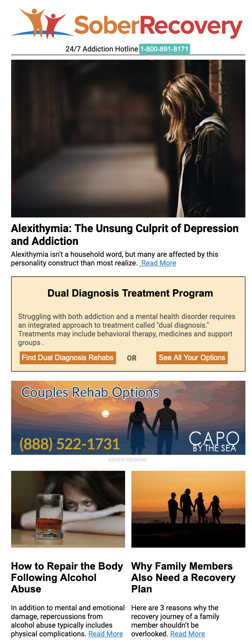Summary of Nicotine Addiction Utica NY
Substance abuse , Buprenorphine Services
Types of Care
Residential short-term treatment (30 days or less)
Special Programs/Groups
Persons with co-occurring mental and substance abuse disorders, Women, Men

Substance abuse , Halfway house
Types of Care
Residential long-term treatment (more than 30 days)
Special Programs/Groups
Women

Substance abuse
Types of Care
Residential long-term treatment (more than 30 days)

Substance abuse , Halfway house
Types of Care
Residential long-term treatment (more than 30 days)

Substance abuse , Detoxification, Methadone Maintenance, Methadone Detoxification, Buprenorphine Services
Types of Care
Outpatient
Language Services
Norwegian, Polish, Russian, Spanish

Substance abuse
Types of Care
Outpatient
Special Programs/Groups
Adolescents, Persons with co-occurring mental and substance abuse disorders, Women, Men, DUI/DWI offenders, Criminal justice clients

Utica, NY
Substance abuse
Types of Care
Outpatient
Special Programs/Groups
Adolescents, Persons with co-occurring mental and substance abuse disorders, Gays and Lesbians, Women, Men, Criminal justice clients
Language Services
ASL or other assistance for hearing impaired

Utica, NY
Substance abuse , Halfway house
Types of Care
Residential long-term treatment (more than 30 days)
Special Programs/Groups
Men

Detoxification
Types of Care
Residential short-term treatment (30 days or less)

Substance abuse
Types of Care
Outpatient
Special Programs/Groups
Adolescents, Women, Criminal justice clients


Summary of Nicotine Addiction
Nicotine Addiction is a well-known among the teen community. Nicotine dependence can be successfully treated. The drug ‘Nicotine’ is a psychoactive drug with effects that reinforce tobacco use even though known harmful health effects. Family physicians are in an excellent position to promote both smoking cessation and smoking prevention. Nicotine is a psychoactive agent whose continued use usually leads to addiction. The pharmacologic and psychologic processes that determine nicotine addiction are similar to those that determine addiction to other drugs, such as heroin and cocaine. The most common form of nicotine dependence is associated with the inhalation of cigarette smoke. Pipe and cigar smoking, tobacco chewing and the use of snuff are less likely to lead to nicotine dependence. This article, therefore, focuses on cigarette smoking as the primary agent of nicotine addiction.
Cigarette smoking may be responsible for as many as 350,000 deaths annually in the United States, representing 18 percent of all deaths. Total costs of smoking-related health care and lost productivity amount to approximately $65 billion each year.
Despite escalating cigarette consumption worldwide, U.S. smoking rates are declining. Consumption reached a peak in the early 1960s, when 42 percent of adults smoked (52 percent of men and 34 percent of women). Per capita consumption began to drop after 1964, when the U.S. Surgeon General reported tobacco use to be a major health hazard. Currently, 26...
Click here to read the rest of this article from Sober Recovery
Featured Facilities
At Skywood, we are deeply invested in helping you regain your health. Our programming approach to recovery is designed with that in mind, from individual and group therapy to adventure therapy, art therapy and yoga. Each of these activities builds on the others to get to the root causes of addiction, introduce healthy new habits, address any co-occurring mental health issues and provide the mental and physical space you need in order to heal. We also provide access to regular 12-Step meetings and peer support groups. What we do at Skywood is different for several reasons. First, we treat addiction and mental health at the same time in a highly integrated way, looking to restore a person’s physical, emotional, mental and spiritual well-being. Second, we focus on resolving trauma, underlying issues and deep-rooted emotional pain that often causes substance abuse in the first place. Lastly, we emphasize life skills that help each person build a foundation for sustainable, long-term recovery.
Located in Orange County, California, Connections Mental Health is a residential treatment center that focuses on treating a range of mental health conditions. It treats a maximum of 6 clients at a time to create individualized care. With compassion at the core of its approach, the team provides a comprehensive evaluation before treatment to customize clients’ care plans to meet a diversity of needs.Mental Health Treatment Connections Mental Health can help those with depression, anxiety, post-traumatic stress disorder (PTSD), bipolar disorder, borderline personality disorder (BPD), obsessive-compulsive disorder (OCD), schizophrenia, attention-deficit/hyperactivity disorder (ADHD), and suicidal and homicidal ideation. Connections Mental Health additionally has a 24/7 supervised eating disorder program backed by a team of psychiatrists, psychologists, dietitians, and medical doctors. They offer a special program for people with premenstrual dysphoric disorder (PMDD).Comprehensive TherapiesConnections Mental Health uses 1:1, group, and family-based therapy (FBT) to help clients recover. FBT restores healthy habits and builds open communication within the family. They offer evidence-based therapies such as cognitive behavioral therapy (CBT), dialectical behavioral therapy (DBT), eye movement desensitization and reprocessing (EMDR), and motivational interviewing. Connections Mental Health offers medication management based on their clinical assessment. They incorporate the Seeking Safety program into treatment. Seeking Safety creates a safe space to develop coping skills, emotion regulation, and resilience through therapies that focus on healing current feelings and behaviors, not past ones.Holistic HealingConnections Mental Health utilizes holistic tools as part of their rehab process like yoga, mindfulness, and meditation, and other modalities like art therapy, to complement the recovery process. These therapies can help clients develop coping strategies, reduce stress, and improve overall well-being. Connection Mental Health’s Orange County residential home has a backyard with comfortable seating and a firepit.
Alpas Wellness La Plata, LLC is a medical organization with a Drug & Alcohol Treatment Center in Charles County, Maryland. Alpas Wellness offers Drug & Alcohol Addiction, Dual-Diagnosis & Mental Health Treatment to individuals struggling with addiction issues. Recovery is a whole-person journey, mind, body, and spirit. If underlying thinking and feeling processes are not identified and addressed, the risk of relapse increases. Holistic therapy is an evidence-based intervention for effectively treating the person, not simply the disorder.Alpas Wellness is committed to providing a patient-first experience at every encounter – from when you or a loved one picks up the phone or reaches out to the admissions team to when you graduate from an individualized treatment program – and every phase in between. From counseling and therapy to group support and medication-assisted interventions, evidence-based treatment protocols run the gamut of all that modern medicine offers. Continual reassessment of patient progress, treatment effectiveness, and symptom management is required to ensure all patient needs are met.It is not uncommon for substance use disorder sufferers to also suffer from mental health disorders. Co-occurring disorder treatment will address each condition individually to promote holistic healing. Genuinely effective treatment is a holistic process that addresses the mind, body, and soul. To achieve and maintain lasting recovery, completing a full continuum of care is critical.At Alpas Wellness, they’ve cultivated a welcoming and positive environment designed for distraction-free healing and recovery. They have collected an experienced and compassionate team of clinicians and providers to ensure every patient’s recovery experience is smooth and positive.Patient and Family-Centered Treatment For Lasting Recovery is their mission, call today for more information.
Compassionate care for individuals with opioid and alcohol use disorders. Substance use disorders are a leading cause of death, incarceration, hospitalizations, motor vehicle crashes, and numerous medical complications such as hepatitis C and HIV. We are passionate about recovery, and strive to help each patient achieve their own recovery from substance use disorders is a lifelong journey which begins with education, medical optimization, and accountability.We are proud to serve Texas as the Top Houston Suboxone Doctor and the surrounding areas with In-Office and Virtual Visit Appointments! He provides Concierge-level compassionate care for individuals with Opioid and Alcohol Use Disorders and believes treatment for addiction works to help individuals maintain long-term abstinence and recovery.With Dr. Giannotti, appointments are zero-wait, always on time as he specializes in services and treatments such as:- Anxiety treatment- Depression treatment- Insomnia treatment- Medication Assisted Treatment (MAT)Sometimes the smallest step in the right direction ends up being the biggest step in one's life. Tip Toe if you must, but Dr. Giannotti is here to take the step beside you.




